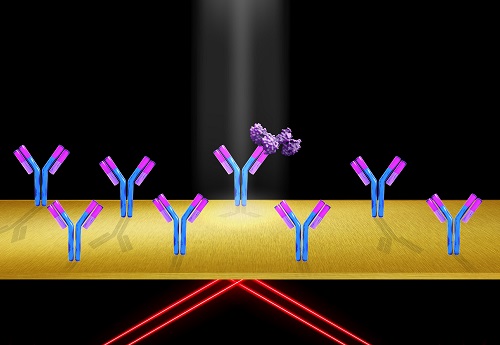TEMPE, Ariz., Sept. 22, 2020 — Researchers at Arizona State University have developed a microscopy technique that harnesses surface plasmon resonance (SPR) to enable precision imaging of individual proteins. SPR has been used to investigate the interactions of bacteria and viruses, but the study is the first time the technique, called plasmon scattering microscopy, has been used to image single molecules, the researchers report.
“The race to develop this technology actually started 20 years ago,” said Shaopeng Wang, researcher in the Biodesign Center for Bioelectronics and Biosensors.

When protein molecules (purple) bind to immobilized receptor molecules (like the Y-shaped antibodies affixed to the slide surface), the refractive index at the gold surface changes, altering the surface plasmon resonance condition and producing an increase in signal intensity. Courtesy of Shireen Dooling.
SPR allows researchers to investigate the dynamics of surface cell proteins, which are primary targets for drug design. Those cells are challenging to observe using techniques such as x-ray crystallography or nuclear magnetic resonance spectroscopy, which are typically used to characterize proteins.
The viability of the technique emerged after Wang and lead author NJ Tao calculated that a modified form of SPR should have the sensitivity to resolve single proteins.
To detect the binding of an analyte molecule (such as a protein) to a receptor molecule using SPR, the receptor molecule is typically immobilized on the sensor surface and the analyte molecule is added to an aqueous solution. Polarized light is then directed under the surface of a thin gold film where surface plasmons are generated at a particular angle of the incident light. The surface confinement of light by the surface plasmon is seen as a decrease in intensity of reflected light.
When protein molecules bind to immobilized receptor molecules, the refractive index at the gold surface changes, altering the surface plasmon resonance condition and producing an increase in signal intensity.
To fine tune the system, the researchers first used it to observe binding events using polystyrene nanoparticles, the size of which they can precisely control. The nanoparticles also have the advantage of producing higher contrast, aiding their detection by SPR. Using smaller and smaller nanoparticles allowed the group to reach the dimensions of a biological protein.
To achieve that resolution, the researchers used a variant of the SPR technique, detecting light on the protein binding events from above, rather than below, which dramatically eliminates background noise and produces a clearer image, or images. Because bound proteins scatter the SPR light in all directions, detection from the top avoids the reflected light, greatly improving image quality.
Wang likens the effect to seeing stars against the background curtain of darkness, whereas stars are invisible to the eye against the noisy background of daylight. Detection of single proteins can be realized without a very powerful light source, since SPR produces strong enhancement to the light field near the sensor surface, clarifying the protein signal.
The researchers expect that the technique will have application in the biomedical and molecular research fields.
The research was published in Nature Methods (www.doi.org/10.1038/s41592-020-0947-0).